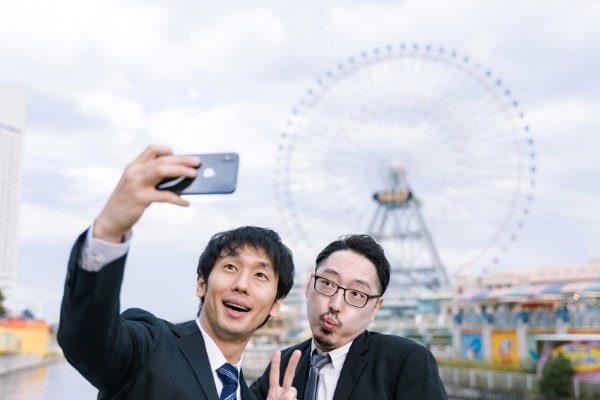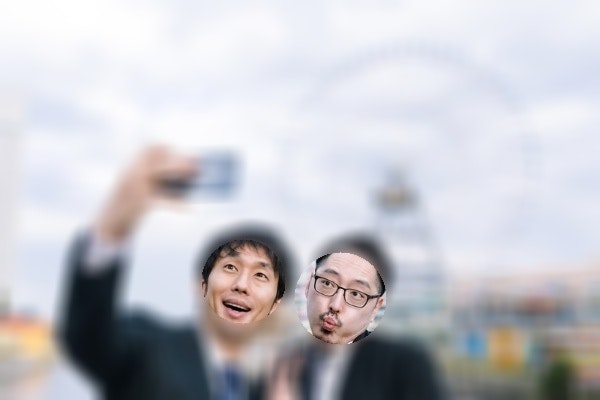はじめに
題名の文章では伝わりにくいので、始めにサンプルを(ぱくたそさんから拝借)
環境
- Windows10
- Python 3.9.4
※python3.6以降とかであれば問題ないかと
pip
python -m pip install cv2
python -m pip install numpy
コード
blur_except_face.py
import cv2
import logging
import numpy as np
import os
import sys
"""
指定画像に対して、顔を検出してそれ以外はモザイクをかけた画像を出力する
Parameters
----------
args[1] : 読み込み画像パス
args[2] : 出力画像パス
"""
def get_detect_data(face_cv2img):
"""
検出処理
Parameters
----------
face_cv2img : numpy.ndarray(cv2画像読み込みデータ)
モザイク加工前のcv2データ
Returns
-------
detect_data : numpy.ndarray
検出データ(座標とサイズ)
"""
# 検出設定
SCALE_FACTOR = 1.11
MIN_NEIGHBORS = 3
MIN_SIZE = (5, 5)
CASCADE_XML = "haarcascade_frontalface_default.xml"
# 検出速度向上のため、モノクロにする
gray_img = cv2.cvtColor(face_cv2img, cv2.COLOR_BGR2GRAY)
# カスケード分類器を設定
cascade = cv2.CascadeClassifier(os.path.join(cv2.data.haarcascades, CASCADE_XML))
# 検出処理&検出データ取得
detect_data = cascade.detectMultiScale(
gray_img, scaleFactor=SCALE_FACTOR, minNeighbors=MIN_NEIGHBORS, minSize=MIN_SIZE
)
return detect_data
def make_blurimg_except_face(face_cv2img, detect_data):
"""
顔以外のぼかし画像を作成
Parameters
----------
face_cv2img : numpy.ndarray(cv2)
モザイク加工前のcv2データ(cv2画像読み込みデータ)
detect_data : numpy.ndarray
検出データ(座標とサイズ)
Returns
-------
blur_face_img : numpy.ndarray(cv2)
顔検出してぼかし加工したcv2データ
※検出が出来ない時は、すべてぼかし
"""
# ぼかしの強弱
BLUR_SIZE = (20, 20)
# 下地のぼかし画像を作成する
blur_face_img = cv2.blur(face_cv2img, BLUR_SIZE)
# 検出できているか(出来ていない場合は、モザイク画像をそのまま返す)
if len(detect_data) > 0:
# 検出値のループ処理
for loc_x, loc_y, size_w, size_h in detect_data:
# 検出内容を抽出
detect_img = face_cv2img[loc_y : loc_y + size_h, loc_x : loc_x + size_w]
# 円形マスク画像の作成
mask_img = np.zeros((size_h, size_w), dtype=np.uint8)
cv2.circle(
mask_img,
center=(size_h // 2, size_w // 2),
radius=max(size_h, size_w) // 2,
color=255,
thickness=-1,
)
# 検出画像をマスク画像を使って円形にする
detect_img[mask_img == 0] = [0, 0, 0]
# RGBA形式に変換する
detect_img_rgba = cv2.cvtColor(detect_img, cv2.COLOR_RGB2RGBA)
# 黒の部分を透明にする
detect_img_rgba[..., 3] = np.where(np.all(detect_img == 0, axis=-1), 0, 255)
# 下地のぼかし画像に検出画像を上に重ねる
blur_face_img[loc_y : size_h + loc_y, loc_x : size_w + loc_x,] = (
blur_face_img[
loc_y : size_h + loc_y,
loc_x : size_w + loc_x,
]
* (1 - detect_img_rgba[:, :, 3:] / 255)
+ detect_img_rgba[:, :, :3] * (detect_img_rgba[:, :, 3:] / 255)
)
return blur_face_img
if __name__ == "__main__":
# コマンド引数取得
args = sys.argv
# 引数エラー処理
if len(args) == 3:
# パス取得
base_photo_path = args[1]
make_photo_path = args[2]
# ベース画像取得
face_cv2img = cv2.imread(base_photo_path)
# 画像ファイルとして読み込めたとき
if face_cv2img is not None:
# 検出処理
detect_data = get_detect_data(face_cv2img)
# モザイク画像作成
blur_face_img = make_blurimg_except_face(face_cv2img, detect_data)
# 画像をファイル出力
cv2.imwrite(make_photo_path, blur_face_img)
else:
# 指定パスに画像がないとき
print("Can not file reading")
実行方法
python blur_except_face.py sample.jpg blursample.jpg
※引数は [読み込みファイル名] [出力ファイル名]
参考
さいごに
透過の扱いが難しい、、、

